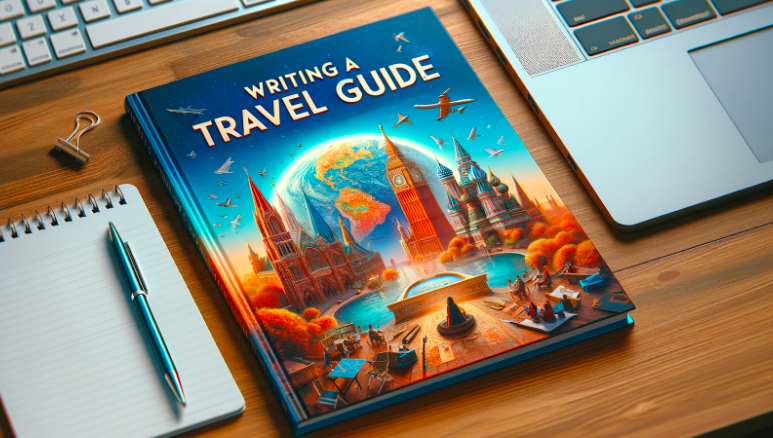Travel book writing is an art that transports readers to new destinations, offering a glimpse into different cultures, landscapes, and adventures. Crafting an engaging and informative travel guide is essential for providing valuable insights and practical advice to travelers.
A well-written travel guide not only captivates its audience with vivid descriptions and unique stories but also serves as a reliable source of information on various aspects such as accommodations, transportation, and local attractions. For writers, creating a travel guide is a rewarding experience that allows them to share their passion for exploration and their personal travel stories.
For readers, it offers an invaluable resource that aids in planning their journeys, ensuring they make the most of their trips. By blending engaging narratives with factual details, travel guides become indispensable companions for anyone looking to embark on new adventures.
Overview: Key Tips for Writing an Effective Travel Guide
Let’s discuss the main points to help you craft an engaging and practical travel guide for all types of travelers.
Travel Guide Fundamentals:
- Understand the purpose of travel guides and the types available (books, blogs, articles).
Engaging and Informative Content:
- Use vivid descriptions and unique stories.
- Ensure content is accurate and detailed.
Practical Tips for Writing:
- Conduct thorough research and organize information logically.
- Include essential details like public transportation and main attractions.
Catering to Budget Travelers:
- Highlight affordable accommodations and money-saving tips.
- Provide cost-effective dining and transportation options.
Assisting Specific Travelers:
- Offer information for families, solo travelers, and those with disabilities.
- Include family-friendly activities, accessibility info, and safety tips.
Visual Elements:
- Use photos, maps, and infographics to enhance engagement.
Personal Travel Stories:
- Share authentic experiences and relatable anecdotes.
- Balance personal stories with practical details.
Promoting Your Guide:
- Utilize SEO and social media for wider reach.
- Keep content updated with fresh perspectives and current information.
Writing a Travel Guide
A travel guide is a comprehensive resource designed to assist travelers in navigating new destinations. It provides essential information about a location, including its attractions, accommodations, dining options, transportation, cultural insights, and practical tips. The primary role of a travel guide is to help travelers make informed decisions, ensuring their trips are enjoyable, efficient, and enriching.
Travel guides play a crucial role in helping travelers by offering a wealth of knowledge that might be difficult to find otherwise. They serve as a reliable source of information, detailing the best times to visit, must-see landmarks, local customs, and safety tips. Additionally, travel guides often include personal recommendations and unique insights from the author, which can enhance the travel experience by uncovering hidden gems and lesser-known spots.
Your Publishing Journey Awaits – Start NowThere are various types of travel guides available, each catering to different preferences and needs. Traditional travel guidebooks are comprehensive and portable, providing in-depth information and maps that are useful for on-the-go reference. Travel blogs offer a more personal touch, often sharing the writer’s firsthand experiences and stories, which can inspire and inform readers in a relatable way. Online articles and digital guides are easily accessible and frequently updated, making them a convenient option for travelers seeking the most current information. Moreover, interactive travel apps combine the best features of these formats, offering multimedia content, real-time updates, and user reviews.
By understanding the different types of travel guides and their roles, writers can create content that truly assists and engages travelers, enhancing their overall travel experience.
Engaging and Informative Content
Engaging and informative content is the cornerstone of an effective travel guide. It captures the reader’s interest and provides them with valuable insights that enhance their travel experience. Engaging content draws readers in, making them feel as if they are part of the journey, while informative content equips them with the knowledge they need to navigate their destination confidently.
To make content engaging, writers should use vivid descriptions that paint a clear picture of the destination. Instead of simply stating facts, describe the vibrant colors of a bustling market, the tantalizing aromas of local cuisine, or the serene sounds of a hidden beach. Incorporating unique stories and personal anecdotes also adds a relatable and human touch. Sharing an unexpected adventure or a meaningful interaction with locals can make the guide more compelling and memorable.
Another tip for engaging content is to vary the writing style and structure. Use a mix of short and long sentences, and include bullet points for quick tips or highlights. Adding humor or interesting trivia can also keep readers entertained and invested in the guide.
Ensuring that content is informative involves thorough research and attention to detail. Provide specific details such as addresses, opening hours, prices, and contact information for attractions, restaurants, and accommodations. Include practical tips on how to get around, such as public transportation options or car rental advice. Highlight important cultural norms and etiquette to help travelers blend in and show respect for local customs.
Additionally, using credible sources and verifying information is crucial. Outdated or incorrect information can lead to frustration and inconvenience for travelers. Including maps, charts, and hyperlinks to official websites or further readings can also enhance the informativeness of the guide.
By combining engaging narratives with precise and factual information, travel guides can offer a comprehensive and enjoyable reading experience that both inspires and assists travelers on their journeys.
Practical Tips for Writing a Travel Guide
Writing a travel guide requires thorough research, careful organization, and the inclusion of practical information to ensure it is both useful and engaging for readers. Here are some practical tips to help you create a comprehensive and reliable travel guide.
Research and Gathering Information
Start by conducting extensive research on the destination. Use a variety of sources, including books, travel blogs, official tourism websites, and local news outlets. Reach out to locals or recent travelers to get firsthand insights and tips. Visit travel forums and social media groups to understand common traveler questions and concerns. Take detailed notes and keep track of sources to ensure the accuracy of your information.
Structuring and Organizing the Guide
A well-structured guide is easier to read and navigate. Begin with an introduction that gives an overview of the destination, highlighting its unique features and what travelers can expect. Organize the main content into clear sections, such as “Getting There,” “Where to Stay,” “What to Eat,” and “Things to Do.” Use subheadings, bullet points, and numbered lists to break up text and make it more digestible. Include a table of contents or an index for quick reference. Ensure that each section flows logically, guiding the reader through the planning process.
Including Practical Information
Practical information is the backbone of any travel guide. Include details on public transportation options, such as bus routes, subway systems, and car rental services, along with tips on navigating them. Highlight the main attractions, including historical sites, natural landmarks, museums, and popular neighborhoods, providing information on their significance, entry fees, and best visiting times. Offer recommendations for accommodations, from budget hostels to luxury hotels, and dining options, from street food stalls to fine dining restaurants.
Additionally, include safety tips, local customs, and cultural etiquette to help travelers navigate the destination respectfully and securely. Providing emergency contact numbers, language basics, and currency exchange information can further assist travelers in having a smooth and enjoyable trip.
By following these practical tips, you can create a travel guide that is not only informative and well-organized but also genuinely helpful to travelers planning their adventures.
Writing for Budget Travelers
Budget travel guides are becoming increasingly important as more travelers seek to explore the world without breaking the bank. The rise of budget airlines, affordable accommodations, and the sharing economy has made travel more accessible, leading to a growing demand for guides that cater to cost-conscious adventurers.
When writing for budget travelers, it is crucial to include budget-friendly options throughout the guide. Start by highlighting affordable accommodations such as hostels, guesthouses, and budget hotels. Provide information on booking platforms that offer the best deals and tips on securing discounts. Consider recommending alternative lodging options like vacation rentals, couch surfing, or house-sitting.
Saving money on food is another key aspect of budget travel. Suggest inexpensive dining options such as local markets, street food stalls, and budget-friendly restaurants. Include tips on finding meal deals, cooking in shared kitchens, or taking advantage of complimentary hotel breakfasts.
Transportation can be a significant expense, so offer advice on cost-effective ways to get around. Highlight public transportation options like buses, trams, and trains, which are often cheaper than taxis or car rentals. Share tips on using ride-sharing services, bike rentals, or even walking to explore the destination.
To appeal to budget travelers, tailor your content to address their specific needs and preferences. Use a friendly and approachable tone, and emphasize value-for-money experiences. Include practical tips on saving money, such as using discount cards, free attractions, or traveling during off-peak seasons. Highlight activities and experiences that are either low-cost or free, such as hiking trails, public parks, or local festivals.
By focusing on budget-friendly options and practical advice, you can create a travel guide that resonates with budget travelers and helps them make the most of their trips without overspending.
Assisting Travelers with Specific Needs
Catering to different types of travelers is essential in creating a travel guide that is inclusive and helpful for a wide audience. Travelers have varied preferences and requirements, and addressing these can significantly enhance their travel experience. Whether it’s families, solo travelers, seniors, or people with disabilities, each group has unique needs that must be considered.
Family Travels
For families, it is important to provide information on family-friendly activities and attractions. Highlight parks, playgrounds, and museums with interactive exhibits that are suitable for children. Include tips on kid-friendly restaurants, accommodations with family rooms, and safety tips for traveling with young children. Additionally; recommend activities that the whole family can enjoy together, such as nature hikes or cultural festivals.
Solo Travelers
Solo travelers often seek social experiences and safety tips. Suggest social hostels, group tours, and popular spots for meeting other travelers. Offer advice on staying safe while traveling alone, such as choosing well-lit areas, keeping emergency contacts handy, and being aware of local customs.
Accessibility
Accessibility is a crucial consideration for travelers with disabilities. Provide detailed information on accessible accommodations, transportation options, and attractions. Highlight destinations with good infrastructure for wheelchair users, such as ramps, elevators, and accessible restrooms. Include tips on where to find medical facilities and how to navigate the local terrain comfortably.
Senior Travelers
Seniors may prefer a more relaxed pace and comfortable accommodations. Recommend destinations known for their senior-friendly amenities, such as easy-to-navigate public transport, guided tours, and accommodations with senior discounts.
By tailoring your travel guide to address the specific needs and preferences of various audiences, you create a resource that is valuable to a diverse group of travelers. This inclusive approach ensures that everyone can find relevant information and enjoy their travels to the fullest.
Visual Elements in a Travel Guide
Visual elements play a crucial role in enhancing travel guides by making them more engaging, informative, and appealing. Well-chosen visuals can bring a destination to life, helping readers visualize the places they plan to visit and inspiring them to explore further.
Incorporating visually appealing elements such as photos, maps, and infographics can significantly enhance the reader’s experience. High-quality photos of landscapes, landmarks, and local culture add color and context to the descriptions, making the guide more immersive. When selecting photos, ensure they are relevant, well-composed, and capture the essence of the destination. Including a mix of wide shots, close-ups, and candid moments can provide a comprehensive visual narrative.
Your Publishing Journey Awaits – Start NowMaps are essential for helping readers navigate a new place. They can illustrate the layout of a city, highlight key attractions, and show the best routes for getting around. Interactive maps, where readers can click for more details, are especially useful in digital travel guides. Ensure maps are clear, easy to read, and accurately labeled.
Infographics are another effective visual tool. They can simplify complex information, such as transportation routes or travel itineraries, making it more accessible. Use infographics to break down data into visually digestible chunks, such as cost comparisons or weather patterns.
Visuals help in making the guide more engaging by breaking up long blocks of text, adding visual interest, and providing a quick reference for important information. They cater to visual learners and can make the content more memorable. Additionally, a visually appealing guide is more likely to be shared on social media, increasing its reach and impact.
By thoughtfully incorporating photos, maps, and infographics, you can create a travel guide that is not only informative but also visually captivating, helping readers connect with the content on a deeper level.
Sharing Personal Travel Stories
Personal travel stories have a powerful impact on readers, offering a unique and relatable perspective that factual information alone cannot provide. These narratives can inspire, entertain, and create an emotional connection with the audience, making the travel guide more engaging and memorable.
To share travel experiences in a relatable way, focus on authenticity and honesty. Write in a conversational tone as if sharing your story with a friend. Include vivid descriptions that engage the senses, helping readers visualize and feel the experiences. Mention specific details that add depth and personality to the story, such as interactions with locals, unexpected challenges, or serendipitous discoveries.
When crafting your stories, aim to highlight moments that resonate universally, such as the joy of discovering a hidden gem, the thrill of adventure, or the comfort of a home-cooked meal in a foreign land. These shared human experiences can make your stories more relatable and compelling.
Balancing personal anecdotes with factual information is crucial for maintaining the guide’s usefulness. While your stories add color and character, ensure they are complemented by practical details that readers need. For example, if you describe an unforgettable meal at a local restaurant, provide the restaurant’s name, location, and signature dishes. If you recount a scenic hike, include information on the trailhead, difficulty level, and any necessary permits.
Integrate your personal stories seamlessly within the guide’s structure. Use them to illustrate points or enhance sections with real-life examples. This balance ensures that your guide remains both informative and engaging, offering readers valuable insights along with a personal touch that brings the destination to life. By sharing personal travel stories effectively, you create a travel guide that not only informs but also inspires and connects with readers on a deeper level.
Promoting Your Travel Guide
Promoting your travel guide effectively is essential for reaching a wider audience and ensuring your content makes an impact. Utilizing a combination of search engine optimization (SEO) and social media strategies can significantly boost your guide’s visibility.
SEO Strategies
Optimize your travel guide for search engines by incorporating relevant keywords throughout the content. Use phrases like “best travel guide,” “affordable travel tips,” and “local attractions” to improve search rankings. Write compelling meta descriptions and use headings and subheadings to organize your content, making it easier for search engines to index. Additionally, include internal and external links to credible sources, enhancing your guide’s authority and relevance.
Social Media Strategies
Leverage social media platforms to share your travel guide and engage with your audience. Post visually appealing snippets, such as beautiful photos or interesting facts, to attract attention. Use hashtags relevant to travel and your destination to reach a broader audience. Engage with travel communities and groups on platforms like Facebook, Reddit, and Instagram to share your guide and get feedback.
Increasing Traffic
To increase traffic, make your content easily scannable with bullet points, lists, and highlighted tips. Collaborate with other travel bloggers or influencers to share your guide and reach their audiences. Encourage readers to share your guide by including social sharing buttons.
Creating an Author Website
Creating an author website is a valuable tool for writers, offering a dedicated space to showcase their work and build a personal brand. It serves as a central hub where readers can learn about the author’s books, upcoming projects, and background. An author website also provides a platform for engaging with fans through blogs, newsletters, and social media links, fostering a deeper connection with the audience. Additionally, it enhances discoverability, making it easier for readers, agents, and publishers to find and explore an author’s portfolio. Overall, an author website is a powerful marketing tool that helps establish credibility and grow a loyal readership.
Fresh Perspective and Staying Updated
A fresh perspective keeps your guide relevant and appealing. Regularly update your content to reflect new information, trends, and personal experiences. Staying current ensures your travel guide remains a valuable resource, attracting repeat visitors and maintaining its usefulness over time.
By implementing these strategies, you can effectively promote your travel guide, increase its visibility, and provide valuable content to a wider audience.
Conclusion
In summary, crafting an engaging and informative travel guide involves thorough research, vivid storytelling, practical tips, and inclusive content. By incorporating visuals and personal anecdotes, you can create a guide that captivates and assists travelers. Promoting your guide through SEO and social media will help reach a wider audience. We encourage you to start writing your own travel guides, and sharing your unique experiences and insights. Travel writing is a rewarding endeavor, offering the joy of exploration and the opportunity to inspire and assist others in their journeys. Embrace the adventure and begin your travel writing journey today.
Your Publishing Journey Awaits – Start Now






